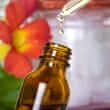Background
- Devil's claw (Harpagophytum procumbens) originates from the Kalahari and Savannah desert regions of South and Southeast Africa. In these parts of the world, devil's claw has historically been used to treat a wide range of conditions including fever, malaria, and indigestion. The medicinal ingredient of the devil's claw plant is extracted from the dried out roots.
- Currently, the major uses of devil's claw are as an anti-inflammatory and pain reliever for joint diseases, back pain, and headache. There is currently widespread use of standardized devil's claw for mild joint pain in Europe.
- Potential side effects include gastrointestinal upset, low blood pressure, or abnormal heart rhythms (increased heart rate or increased heart squeezing effects).
- Traditionally, it has been recommended to avoid using devil's claw in patients with stomach ulcers or in people using blood thinners (anticoagulants such as warfarin/Coumadin®).
References
Natural Standard developed the above evidence-based information based on a thorough systematic review of the available scientific articles. For comprehensive information about alternative and complementary therapies on the professional level, go to . Selected references are listed below.
- Chantre P, Cappelaere A, Leblan D, et al. Efficacy and tolerance of Harpagophytum procumbens versus diacerhein in treatment of osteoarthritis. Phytomedicine 2000;7(3):177-183.
View Abstract - Chrubasik S, Model A, Black A, et al. A randomized double-blind pilot study comparing Doloteffin® and Vioxx® in the treatment of low back pain. Rheumatology 2003;42:141-148.
- Chrubasik S, Sporer F, Wink M. [Harpagoside content of different powdered dry extracts from Harpagophytum procumbens]. Forsch Komplmentarmed 1996;3:6-11.
- Chrubasik S, Sporer F, Wink M, et al. Zum wirkstoffgehalt in arzneimitteln aus harpagophytum procumbens. Forsch Komplementärmed 1996;3:57-63.
- Chrubasik S, Conradt C, Black A. The quality of clinical trials with Harpagophytum procumbens. Phytomedicine 2003;10(6-7):613-623.
View Abstract - Chrubasik S, Conradt C, Roufogalis BD. Effectiveness of Harpagophytum extracts and clinical efficacy. Phytother Res 2004;18(2):187-189.
View Abstract - Chrubasik S, Junck H, Breitschwerdt H, et al. Effectiveness of Harpagophytum extract WS 1531 in the treatment of exacerbation of low back pain: a randomized, placebo-controlled, double- blind study. Eur J Anaesthesiol 1999;16(2):118-129.
View Abstract - Circosta C, Occhiuto F, Ragusa S, et al. A drug used in traditional medicine: Harpagophytum procumbens DC. II. Cardiovascular activity. J Ethnopharmacol 1984;11(3):259-274.
View Abstract - Ernst E, Chrubasik S. Phyto-anti-inflammatories. A systematic review of randomized, placebo-controlled, double-blind trials. Rheum Dis Clin North Am 2000;26(1):13-27.
View Abstract - Grant L, McBean DE, Fyfe L, et al. A review of the biological and potential therapeutic actions of Harpagophytum procumbens. Phytother Res 2007;21(3):199-209.
View Abstract - Gagnier JJ, van Tulder MW, Berman B, et al. Herbal medicine for low back pain: a Cochrane review. Spine 1-1-2007;32(1):82-92.
View Abstract - Heck AM, DeWitt BA, Lukes AL. Potential interactions between alternative therapies and warfarin. Am J Health Syst Pharm 2000;57(13):1221-1227.
View Abstract - Lanhers MC, Fleurentin J, Mortier F, et al. Anti-inflammatory and analgesic effects of an aqueous extract of Harpagophytum procumbens. Planta Med 1992;58(2):117-123.
View Abstract - Laudahn D, Walper A. Efficacy and tolerance of Harpagophytum extract LI 174 in patients with chronic non-radicular back pain. Phytother Res 2001;15(7):621-624.
View Abstract - Wegener T, Lupke NP. Treatment of patients with arthrosis of hip or knee with an aqueous extract of devil's claw (Harpagophytum procumbens DC.). Phytother Res 2003;17(10):1165-1172.
View Abstract







